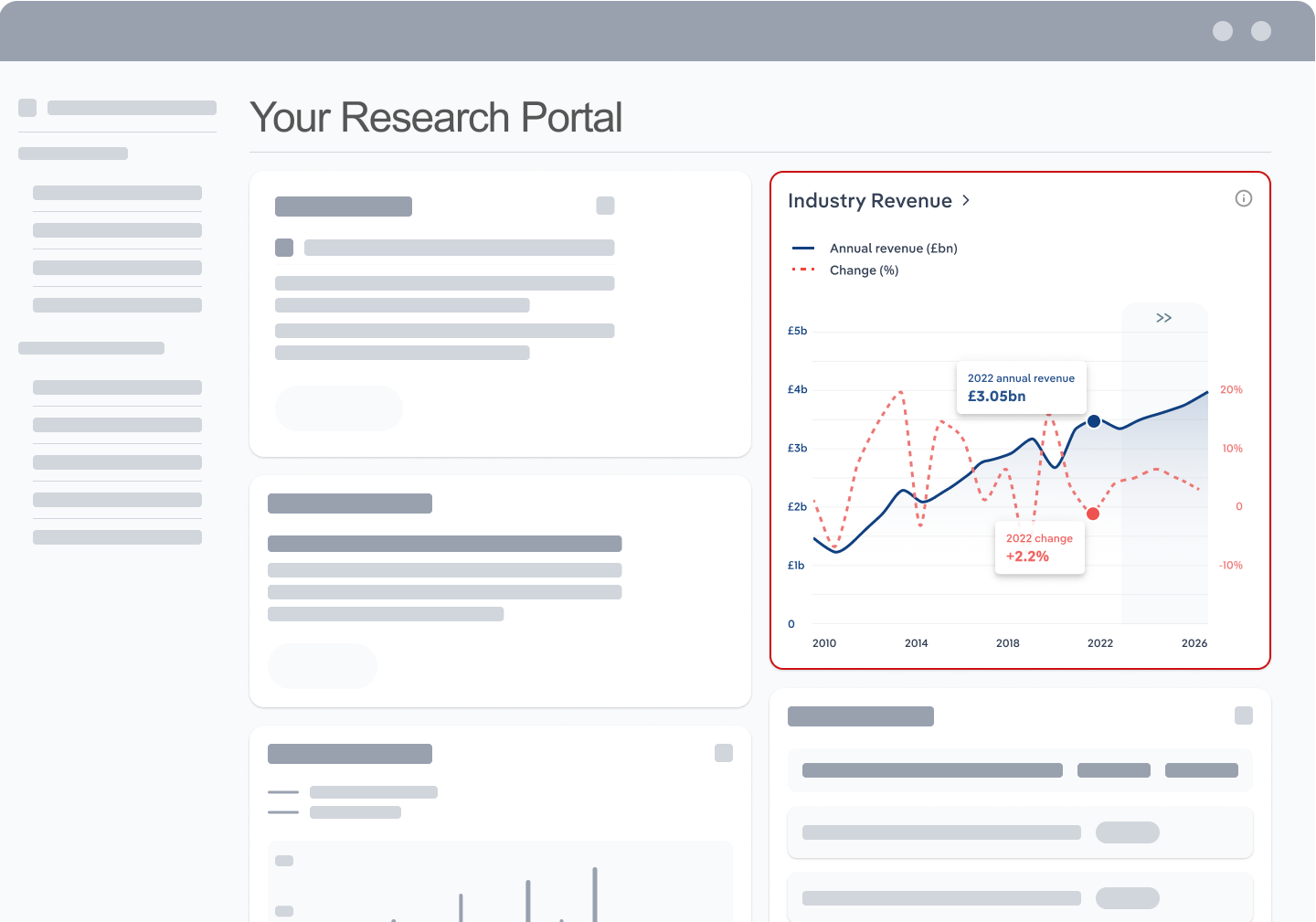Industry Statistics and Trends
Market size and recent performance (2014-2029)
Industry revenue has declined at a CAGR of 6.6 % over the past five years, to reach an estimated $4.6bn in 2024.
Trends and Insights
The vast majority of society has gone wireless
- Since 2013, more Canadian households have subscribed exclusively to mobile wireless services than to wireline telephone services. The number of Canadian households abandoning traditional telephone and TV services is increasing daily. Sales of new landlines have plummeted as more Canadians embrace wireless communication. According to 2022 figures from the CRTC, only 5.3% of the broader telecoms industry's revenue results from private sales of landlines.
- Additional trends and insights available with purchase
Industry outlook (2025-2030)
Market size is projected to decline over the next five years.
Trends and Insights
Cord-cutting trends intensify
- Voice over Internet Protocol (VoIP) residential lines, like the service provided by Videotron Ltd., will become the more common technology for residential landlines as companies focus on their internet business segments. VoIP services are often easily bundled with internet services, which can provide savings and convenience.
Biggest companies in the Wired Telecommunications Carriers in Canada
| Company | Market Share (%)
2024 | Revenue ($m)
2024 | Profit ($m)
2024 | Profit Margin (%)
2024 |
|---|---|---|---|---|
BCE Inc. | 1,530.7 | 375.7 | 24.5 | |
TELUS Communications Company | 1,491.5 | 209.7 | 14.1 | |
Rogers Communications Inc. | 168.2 | 40.7 | 24.2 |
To view the market share and analysis for all 3 top companies in this industry, view purchase options.
Products & Services Segmentation
Industry revenue is measured across several distinct product and services lines, including Local voice services , Long-distance voice services and Other services and equipment. Local voice services is the largest segment of the Wired Telecommunications Carriers in Canada.
Trends and Insights
Local calls remain critical for business contiuity
- Local voice services in Canada have traditionally been the backbone of the landline and wired telephone industry. Despite the encroachment of mobile and internet technologies, they've provided dependable communication solutions.
- More insights available in the full report
Table of Contents
About this industry
Industry definition
The Wired Telecommunications Carriers industry in Canada provides local and long-distance telephony services. Carriers also generate revenue by wholesaling access to their networks for many purposes, and selling or renting telecommunications equipment.
What's included in this industry?
Products and services covered in the Wired Telecommunications Carriers industry in Canada include Providing local voice communication services, Providing long-distance and international voice communication services and Selling other services and telecommunications equipment.Companies
Companies covered in the Wired Telecommunications Carriers industry in Canada include BCE Inc., TELUS Communications Company and Rogers Communications Inc.Purchase this report to view all 3 major companies in this industry.
Related Terms
Related terms covered in the Wired Telecommunications Carriers industry in Canada include access line, competitive local exchange carrier, core network, incumbent local exchange carrier (ilec), integrated services digital network, local access and transport area (lata), public switched telephone network, iptv (internet protocol television) and byod (bring your own device).Industry Code
NAICS 51711 - Wired Telecommunications Carriers in Canada
Performance
Get an indication of the industry's health through historical, current and forward-looking trends in the performance indicators that make or break businesses.
Analyst insights
Wireless services are eclipsing traditional landlines. Canadians, fueled by the advent of 5G networks, prefer the mobility and versatility of wireless communication over slow...
In this chapter (4)
- Current Performance
- Outlook
- Volatility
- Life Cycle
Key metrics
- Annual Revenue, Recent Growth, Forecast, Revenue Volatility
- Number of Employees, Recent Growth, Forecast, Employees per Business, Revenue per Employee
- Number of Businesses, Recent Growth, Forecast, Employees per Business, Revenue per Business
- Total Profit, Profit Margin, Profit per Business
Charts
- Revenue, including historical (2014-2023) and forecast (2024-2029)
- Employees, including historical (2014-2023) and forecast (2024-2029)
- Businesses, including historical (2014-2023) and forecast (2024-2029)
- Profit, including historical (2014-2024)
- Industry Volatility vs. Revenue Growth
- Industry Life Cycle
Detailed analysis
- Trends in supply, demand and current events that are driving current industry performance
- Expected trends, economic factors and ongoing events that drive the industry's outlook
- Key success factors for businesses to overcome volatility
- How contribution to GDP, industry saturation, innovation, consolidation, and technology and systems influence the industry's life cycle phase.
Products and Markets
Learn about an industry's products and services, markets and trends in international trade.
Analyst insight
Landlines still play a crucial role as a backup. Despite the surge of mobile and VoIP services, landlines remain essential for their reliability. They serve as a fail-safe fo...
In this chapter
- Products & Services
- Major Markets
Key metrics
- Largest market segment and value in 2024
- Product innovation level
Charts
- Products & services segmentation in 2024
- Major market segmentation in 2024
Detailed analysis
- Trends impacting the recent performance of the industry's various segments
- Innovations in the industry's product or service offering, specialization or delivery method
- Key factors that successful businesses consider in their offerings
- Buying segments and key trends influencing demand for industry products and services
Geographic Breakdown
Discover where business activity is most concentrated in an industry and the factors driving these trends to find opportunities and conduct regional benchmarking.
Analyst insights
High population density drives telecommunication demand in cities. Metropolitan areas like Toronto and Ottawa see unmatched needs due to their large, diverse populations.
In this chapter (1)
- Business Locations
Charts
- Share of revenue, establishment, wages and employment in each province
- Share of population compared to establishments in each region in 2024
Tables
- Number and share of establishments in each province in 2024
- Number and share of revenue each province accounts for in 2024
- Number and share of wages each province accounts for in 2024
- Number and share of employees in each province in 2024
Detailed analysis
- Geographic spread of the industry across North America, and trends associated with changes in the business landscape
- Key success factors for businesses to use location to their advantage
Competitive Forces
Get data and insights on what's driving competition in an industry and the challenges industry operators and new entrants may face, with analysis built around Porter's Five Forces framework.
Analyst insights
Newer forms of service delivery are changing the competitive landscape. Wireless and VoIP technology are slashing the need for access lines and conventional voice services pr...
In this chapter (4)
- Concentration
- Barriers to Entry
- Substitutes
- Buyer & Supplier Analysis
Key metrics
- Industry concentration level
- Industry competition level and trend
- Barriers to entry level and trend
- Substitutes level and trend
- Buyer power level and trend
- Supplier power level and trend
Charts
- Market share concentration among the top 4 suppliers from 2019-2024
- Supply chain including upstream supplying industries and downstream buying industries, flow chart
Detailed analysis
- Factors impacting the industry’s level of concentration, such as business distribution, new entrants, or merger and acquisition activity.
- Key success factors for businesses to manage the competitive environment of the industry.
- Challenges that potential industry entrants face such as legal, start-up costs, differentiation, labor/capital intensity and capital expenses.
- Key success factors for potential entrants to overcome barriers to entry.
- Competitive threats from potential substitutes for the industry’s own products and services.
- Key success factors for how successful businesses can compete with substitutes.
- Advantages that buyers have to keep favorable purchasing conditions.
- Advantages that suppliers have to maintain favorable selling conditions.
- Key success factors for how businesses can navigate buyer and supplier power.
Companies
Learn about the performance of the top companies in the industry.
Analyst insights
In 2023, Rogers' merger with Shaw streamlined its operations and solidified its prominence in the wireless telecommunication sector. The $26 billion deal, first announced in ...
In this chapter
- Market Share Concentration
- Companies
- Company Spotlights
Charts
- Industry market share by company in 2020 through 2024
- Major companies in the industry, including market share, revenue, profit and profit margin in 2024
- Overview of BCE Inc.'s performance by revenue, market share and profit margin from 2018 through 2024
- Overview of TELUS Communications Company's performance by revenue, market share and profit margin from 2018 through 2024
- Overview of Rogers Communications Inc.'s performance by revenue, market share and profit margin from 2018 through 2024
Detailed analysis
- Description and key data for BCE Inc., and factors influencing its performance in the industry
- Description and key data for TELUS Communications Company, and factors influencing its performance in the industry
- Description and key data for Rogers Communications Inc., and factors influencing its performance in the industry
External Environment
Understand the demographic, economic and regulatory factors that shape how businesses in an industry perform.
Analyst insights
Canada's Telecommunications Act seeks universal access. It aims to provide high-quality, reliable telecom services at reasonable rates to all Canadians, including those in re...
In this chapter
- External Drivers
- Regulation & Policy
- Assistance
Key metrics
- Regulation & policy level and trend
- Assistance level and trend
Charts
- Regulation & Policy historical data and forecast (2014-2029)
- Assistance historical data and forecast (2014-2029)
Detailed analysis
- Demographic and macroeconomic factors influencing the industry, including Regulation & Policy and Assistance
- Major types of regulations, regulatory bodies, industry standards or specific regulations impacting requirements for industry operators
- Key governmental and non-governmental groups or policies that may provide some relief for industry operators.
Financial Benchmarks
View average costs for industry operators and compare financial data against an industry's financial benchmarks over time.
Analyst insights
Declining landline subscribers hurt profits. As consumers switch to wireless services, companies face increased competition and must cut prices, leading to lower profitabilit...
In this chapter
- Cost Structure
- Financial Ratios
- Key Ratios
Key metrics
- Profit margin, and how it compares to the sector-wide margin
- Average wages, and how it compares to the sector-wide average wage
- Largest cost component as a percentage of revenue
- Industry average ratios for days' receivables, industry coverage and debt-to-net-worth ratio
Charts
- Average industry operating costs as a share of revenue, including purchases, wages, depreciation, utilities, rent, other costs and profit in 2024
- Average sector operating costs as a share of revenue, including purchases, wages, depreciation, utilities, rent, other costs and profit in 2024
- Investment vs. share of economy
Data tables
- Liquidity Ratios (2017-2022)
- Coverage Ratios (2017-2022)
- Leverage Ratios (2017-2022)
- Operating Ratios (2017-2022)
- Assets (2017-2022)
- Liabilities (2017-2022)
- Cash Flow & Debt Service Ratios (2014-2029)
- Revenue per Employee (2014-2029)
- Revenue per Enterprise (2014-2029)
- Employees per Establishment (2014-2029)
- Employees per Enterprise (2014-2029)
- Average Wage (2014-2029)
- Wages/Revenue (2014-2029)
- Establishments per Enterprise (2014-2029)
- IVA/Revenue (2014-2029)
- Imports/Demand (2014-2029)
- Exports/Revenue (2014-2029)
Detailed analysis
- Trends in the cost component for industry operators and their impact on industry costs and profitability
Key Statistics
Industry Data
Data Tables
Including values and annual change:
- Revenue (2014-2029)
- IVA (2014-2029)
- Establishments (2014-2029)
- Enterprises (2014-2029)
- Employment (2014-2029)
- Exports (2014-2029)
- Imports (2014-2029)
- Wages (2014-2029)
Top Questions Answered
Unlock comprehensive answers and precise data upon purchase. View purchase options.
What is the market size of the Wired Telecommunications Carriers industry in Canada in 2025?
The market size of the Wired Telecommunications Carriers industry in Canada is $4.6bn in 2025.
How many businesses are there in the Wired Telecommunications Carriers industry in Canada in 2024?
There are 33 businesses in the Wired Telecommunications Carriers industry in Canada, which has declined at a CAGR of 4.2 % between 2019 and 2024.
How may import tariffs affect the Wired Telecommunications Carriers industry in Canada?
The Wired Telecommunications Carriers industry in Canada is unlikely to be materially impacted by import tariffs with imports accounting for a low share of industry revenue.
How may export tariffs affect the Wired Telecommunications Carriers industry in Canada?
The Wired Telecommunications Carriers industry in Canada is unlikely to be materially impacted by export tariffs with exports accounting for a low share of industry revenue.
Has the Wired Telecommunications Carriers industry in Canada grown or declined over the past 5 years?
The market size of the Wired Telecommunications Carriers industry in Canada has been declining at a CAGR of 6.6 % between 2019 and 2024.
What is the forecast growth of the Wired Telecommunications Carriers industry in Canada over the next 5 years?
Over the next five years, the Wired Telecommunications Carriers industry in Canada is expected to decline.
What are the biggest companies in the Wired Telecommunications Carriers industry in Canada?
The biggest companies operating in the Wired Telecommunications Carriers industry in Canada are BCE Inc., TELUS Communications Company and Rogers Communications Inc.
What does the Wired Telecommunications Carriers industry in Canada include?
Providing local voice communication services and Providing long-distance and international voice communication services are part of the Wired Telecommunications Carriers industry in Canada.
Which companies have the highest market share in the Wired Telecommunications Carriers industry in Canada?
The company holding the most market share in the Wired Telecommunications Carriers industry in Canada is BCE Inc..
How competitive is the Wired Telecommunications Carriers industry in Canada?
The level of competition is high and increasing in the Wired Telecommunications Carriers industry in Canada.
Methodology
How are IBISWorld reports created?
IBISWorld has been a leading provider of trusted industry research for over 50 years to the most successful companies worldwide. With offices in Australia, the United States, the United Kingdom, Germany and China, we are proud to have local teams of analysts that conduct research, data analysis and forecasting to produce data-driven industry reports.
Our analysts start with official, verified and publicly available sources of data to build the most accurate picture of each industry. Analysts then leverage their expertise and knowledge of the local markets to synthesize trends into digestible content for IBISWorld readers. Finally, each report is reviewed by one of IBISWorld’s editors, who provide quality assurance to ensure accuracy and readability.
IBISWorld relies on human-verified data and human-written analysis to compile each standard industry report. We do not use generative AI tools to write insights, although members can choose to leverage AI-based tools within the platform to generate additional analysis formats.
What data sources do IBISWorld analysts use?
Each industry report incorporates data and research from government databases, industry-specific sources, industry contacts, and our own proprietary database of statistics and analysis to provide balanced, independent and accurate insights.
Key data sources in Canada include:
- Statistics Canada
- Industry Canada
- Canadian Business Patterns
Analysts also use industry specific sources to complement catch-all sources, although their perspective may focus on a particular organization or representative body, rather than a clear overview of all industry operations. However, when balanced against other perspectives, industry-specific sources provide insights into industry trends.
These sources include:
- Industry and trade associations
- Industry federations or regulators
- Major industry players annual or quarterly filings
Finally, IBISWorld’s global data scientists maintain a proprietary database of macroeconomic and demand drivers, which our analysts use to help inform industry data and trends. They also maintain a database of statistics and analysis on thousands of industries, which has been built over our more than 50-year history and offers comprehensive insights into long-term trends.
How does IBISWorld forecast its data?
IBISWorld’s analysts and data scientists use the sources above to create forecasts for our proprietary datasets and industry statistics. Depending on the dataset, they may use regression analysis, multivariate analysis, time-series analysis or exponential smoothing techniques to project future data for the industry or driver. Additionally, analysts will leverage their local knowledge of industry operating and regulatory conditions to impart their best judgment on the forecast model.
IBISWorld prides itself on being a trusted, independent source of data, with over 50 years of experience building and maintaining rich datasets and forecasting tools. We are proud to be the keystone source of industry information for thousands of companies across the world.
Learn more about our methodology and data sourcing on the Help Center.










